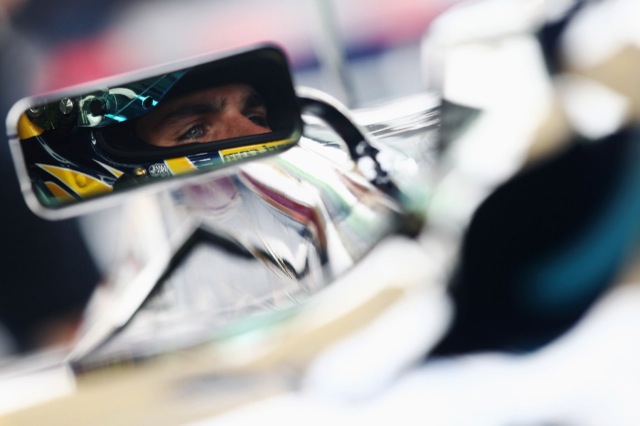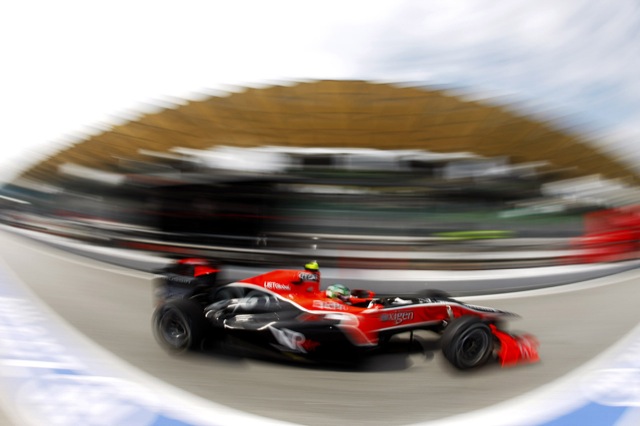With the additional weight of the KERS device this season, many teams and drivers are looking at ways to reduce the impact other parts have in an effort to recoup some of the performance lost by making the car heavier. One area some drivers are considering is their own weight, and talk of dieting has hit Formula One quite substantially this off-season. But is all this talk of weight-loss doing the sport, and its fans, any good?
To explain the weight concept in relation to Formula One, each and every car on the grid has a minimum weight to adhere to. Many years ago it was the opposite and the cars had a maximum weight, but in today’s technologically advanced world, if the team’s weren’t given a minimum weight they would be designing the cars so light it could impact their strength. This could in turn decrease the safety of the driver in the event of an accident. Thus, the minimum weight of a Formula One car and driver is 605kg. This limit has not changed for 2009, despite adding approximately 40kg for the KERS device.
Last year, BMW pilot Robert Kubica famously lost a few kilograms in attempts to improve the performance of his F1.08. Being a tall driver, Kubica obviously weighs a little more than some of his rivals. For example, Robert’s team mate Nick Heidfeld is one of Formula One’s shorter drivers, and so when the cars are being set up, Heidfeld will have more ballast than Kubica to bring his car up to the mandatory minimum weight. This ballast will help Heidfeld because he has more to play with, and therefore has more options as to where it is placed in the car, and therefore has more chance of getting a better balance on his car.
Robert Kubica says his weight loss helped him, and many other drivers looked at the Pole with curious eyes. As you can imagine, drivers who will do almost anything to gain an extra few tenths here and there were now questioning their own position on the bathroom scales. With the knowledge of KERS being introduced but the minimum weight remaining, some drivers have taken up the Kubica Diet and have shed a few pounds over the winter.
Scuderia Toro Rosso driver Sebastien Buemi has been considering losing some weight, the Swiss driver being slightly above the average height of the current crop of Formula One drivers. The rookie explained that adding 10kg to a car reduces the performance of the car by approximately 0.4s/lap; a country mile in Formula One language. Buemi stated to sports newspaper Blick that he wanted to lose 5kg, reducing his weight from 63kg to 58kg.
An article being ran around some of the F1 sites at the moment suggest that for Sebastien Buemi to lose 5kg would put him in the underweight category in most Body Mass Indexes. Having entered Buemi’s information into a couple of BMI calculators, the Swiss driver’s current weight/height/age result puts him firmly in the healthy brackets (20.3). Reducing Sebastien’s weight to 58kg but keeping all other data the same trims his BMI down to 18.7. The suggested limit by the UK’s NHS is 18.5. While a BMI of 18.7 isn’t underweight, it is very close to at least one organisation’s limit.
It should be noted that Body Mass Indexes are a relatively crude way of deciding if someone is over or under weight, and the fact that Buemi is a trim sportsperson who undoubtedly eats good, healthy food and works out a lot probably means he’ll be okay. Although quite how all these slim drivers are going to cope with the oppressively hot Malaysian Grand Prix could be interesting.
However, all this talk of losing weight reminded me of an admission David Coulthard made a couple of years back when his autobiography came out. Coulthard admitted that when he was younger and competing in karts and lower formulae, he found himself suffering with the eating disorder bulimia.
I have always taken racing seriously, even when I started out in karting.
By my teens, however, my focus – in particular, my weight – took a slightly more sinister turn. I was nearly the same height as now but I weighed only just over nine stone.
In my mind the only way to keep my weight down was making myself vomit. David Coulthard.
While I’m sure the drivers of today have very strictly controlled diets and are monitored closely by their team of people around them, if a competitor in motorsport can fall into the trap of an eating disorder, what kind of message is all this talk of weight loss putting out to those who follow the sport and idolise their heroes? Is it perhaps time that instead of dieting stories hitting the headlines around the motorsport press, we see Formula One drivers promoting healthy eating and regular exercise.




















love the title 🙂
Driver heights and weights have been an issue for decades although KERS seems to be highlighting the issue again. If you look at Fangio and co in the 50s a lot of them are chunky at least. By the 60s the 1.5 litre formula meant that with less power weight was an issue and the drivers became a bit lighter.
When Colin Chapman put the engine air intake above the driver’s head on the Lotus 72 he effectively placed a height limit on drivers and when turboengines arrived a few years later the driver’s height became a lot more critical as instead of air being fed into the engine at 1 atmosphere pressure it eventually had to go in at over 5 atmospheres. This resulted in drivers like Gerhard Berger who were the tallest that F1 could accommodat by then having to tilt their heads forward or to the sides on the straights so that they would not limit the airflow to the engine. It is clear that despite tilting his head Berger frequently lost 5-10 km/h on some straights to Senna who was of smaller build.
As aerodynamics required cars to be packaged more tightly the physical size of a driver became more of an issue. For most drivers that meant that they were uncomfortable for someone like Alex Wurz it meant that McLaren had to build a special extended chassis for his use. For Damon Hill who has particularly large feet it meant on occasion cutting the toes of his boot.
Driver height, weight and even shoe size have been an issue for a very long time and KERS is simply the latest step in that direction. At every step the drivers who can be accommodated in F1 cars become shorter, lighter and have smaller feet.
Many drivers who had the ability to drive in F1 did not get the chance because of their size. Matt Neal the British Touring Car Champion is 6 feet 5 so didn’t do single seater racing because his height was such a disadvantage. Gerry Marshall was a massively talented racer in many classes and a lot of people in the know thought he was good enough to do F1 but he weighed 18 stone and enjoyed life way too much to lose the necessary weight.
On the flip side of the coin on of the reasons given for Allan McNish not getting a break in F1 in his teens when he was a highly rated McLaren test driver and had Marlboro sponsorship all through his junior career was that his slight frame may struggle with the demands of F1. Of course that proved to be rubbish as he was the guy who made a habit of doing quadruple stints in sportscar racing when many drivers couldn’t handle triples.
Size and weight will always be an issue in motor racing the only thing that changes or can be changed is where we draw the margin. There will always be someone who can make the weight by dieting aggressively or can be fitted in the car provided he holds his head at an odd angle.
I must learn to proof read
I must learn to proof read
I must learn to proof read
point taken. but, seeing as kers has put the spotlight back onto dieting and weight loss this season, ollie’s right when he says driver’s should be taking extra care to promote healthy eating.
yes it’s a given that they do eat properly, but saying so once in a while wouldn’t hurt. i guess it may not garner much in the way of headlines though.
I never knew that. I wonder if he ever got cold toes while driving.
It is still an awesome comment. Thanks for adding to the article.
It’s a shame that “Kubica Diets” is considered more of an acceptable headline these days than “Kubica Says: 5-a-day Keeps The Doctors Away”.
Excellent post Ollie, thank you. It’s something I touched on in the BBC 606 forum about a month or two ago; that article of mine was met with some ridicule so its nice to see that it’s being taken seriously here.
Do you have a link for that article? I wouldn’t mind a read and I’m sure others would read with interest as well.
Through the powers of chatting on Pitlane Fanatic, Jackie has given me the link to the article: So who’s going on a diet?
As the cars get harder to drive and also quicker the drivers must be fitter and stronger.If they are crash dieting thats impossible.weight limits have to be raised or weight saving has to happen elsewhere
[…] has been utilising the system since the start. This has lead to many drivers shedding weight, which I previously mentioned was perhaps not the best image to be […]
[…] has been utilising the system since the start. This has lead to many drivers shedding weight, which I previously mentioned was perhaps not the best image to be […]
[…] course, the other side of the issue is the fact that many drivers felt the need to shed some weight over the winter in order to accommodate the huge weight of the system, something I feel is wrong […]